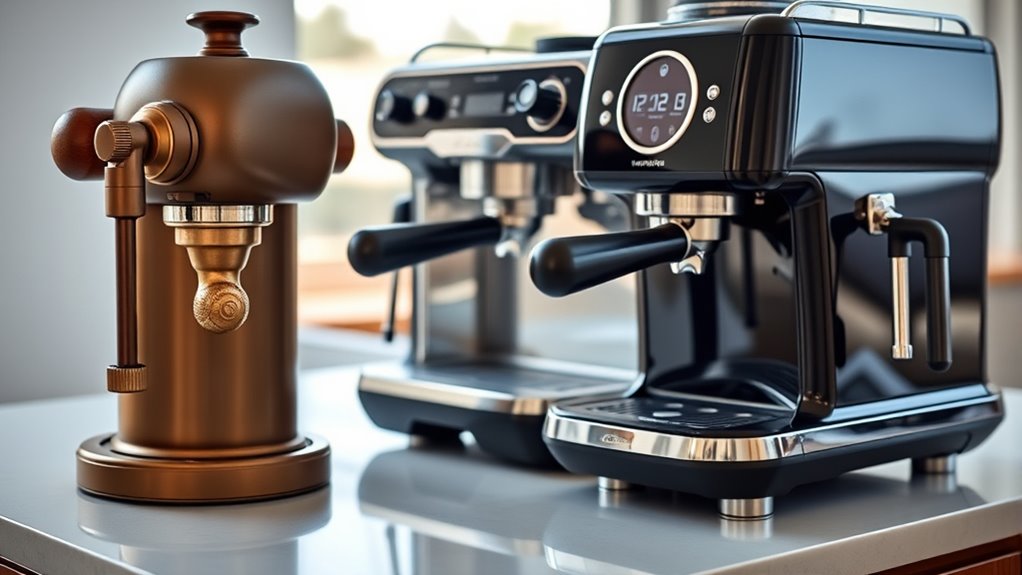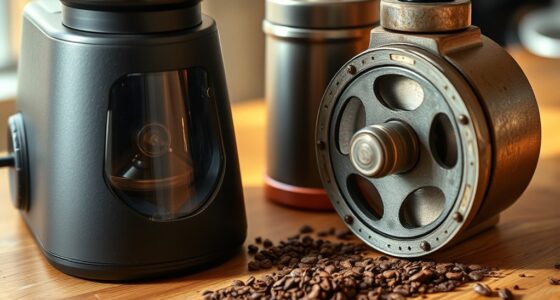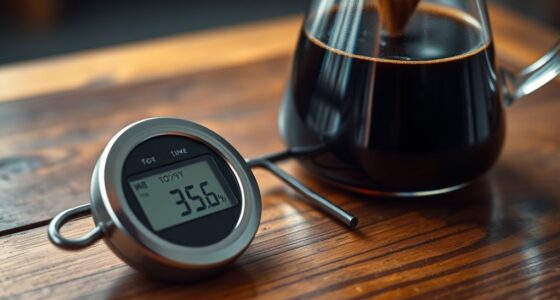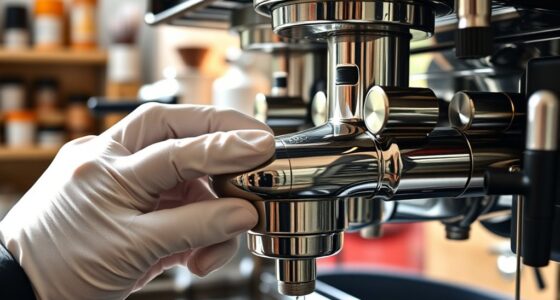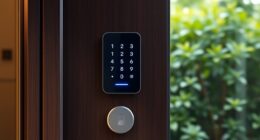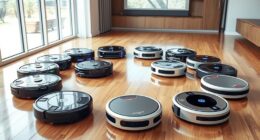Choosing between manual, semi-automatic, and super-automatic espresso machines depends on your skill level and how much control you want. Manual models give you full control over grinding, tamping, and extraction but require practice. Semi-automatic machines automate water pressure and temperature, offering a balance of control and ease. Super-automatic machines handle everything with the push of a button, perfect for convenience. Explore further to discover which suits your brewing style best.
Key Takeaways
- Manual machines offer full control over every step but require skill and patience.
- Semi-automatic machines automate water pressure and temperature, balancing control with ease.
- Super-automatic machines handle grinding, brewing, and frothing automatically for maximum convenience.
- Beginners often prefer semi-automatic or super-automatic options for simpler operation.
- Experienced baristas may choose manual machines for maximum customization and mastery.

Espresso machines are essential tools for coffee enthusiasts who want to craft rich, flavorful espresso at home or in a café. Whether you’re aiming for barista-quality drinks or simply want to enjoy a well-made cup, understanding how these machines work can help you make the right choice. One of the most critical aspects of brewing great espresso is maintaining consistent grinding consistency. When you grind your beans, you need a uniform texture so that water passes through evenly, extracting the full flavor without bitterness or under-extraction. A burr grinder often offers better control over grind size, which directly impacts the espresso’s taste and crema. Proper grinding consistency makes a noticeable difference, especially when you’re trying to perfect your milk frothing techniques. If your espresso shot is too weak or too bitter, adjusting your grind size can help, and the same applies when you’re steaming milk. A good machine allows you to focus on frothing milk to the right temperature and texture, creating that velvety microfoam that complements your espresso perfectly. Whether you favor traditional manual models, semi-automatic, or super-automatic machines depends on how much control you want during the brewing process. Manual machines give you the ultimate hands-on experience—you control every step, from grinding to tamping to pulling the shot. This can be rewarding but requires skill and patience, especially when perfecting milk frothing techniques. Semi-automatic machines strike a balance; they automate some functions like water pressure and temperature, but you still manually control extraction and steaming. This setup offers more consistency than manual machines, making it easier to hone your skills and produce a high-quality espresso shot with well-textured milk. Super-automatic machines take convenience further by automating nearly every step, from grinding to brewing and frothing. These machines are perfect if you want consistent results without much effort. They often come with programmable settings, so you can customize your drinks and achieve the ideal milk foam texture automatically. However, they may lack the nuanced control that true baristas or enthusiasts value. Additionally, maintenance and calibration of your machine play a vital role in ensuring sustained performance and consistent quality. Regardless of the type you choose, investing in a machine that allows you to refine grinding consistency and practice milk frothing techniques will elevate your coffee game. The right equipment simplifies the process, making it easier to experiment and perfect your craft. If you’re a beginner, a semi-automatic or super-automatic machine provides a forgiving platform to learn and improve. For seasoned baristas or enthusiasts, manual machines offer the challenge and control needed to truly master espresso making. Achieving consistent image quality depends heavily on maintaining the right grind size and calibration for your machine, which is vital for optimal extraction and flavor. Ultimately, your choice depends on how involved you want to be, but focusing on consistency in grind size and mastering milk frothing techniques will always lead to better, more satisfying coffee.
Frequently Asked Questions
Which Type of Espresso Machine Is Easiest for Beginners?
You’ll find that super-automatic espresso machines are the easiest for beginners because of their low learning curve and high user-friendliness. They handle most steps automatically, so you don’t need to master complex techniques. With just a push of a button, you get a quality espresso. This simplicity allows you to enjoy great coffee without the frustration of manual adjustments or intricate settings.
How Long Does It Take to Brew a Shot With Each Machine?
Imagine your espresso journey as a race against time. With manual machines, you control the pace, taking about 20-30 seconds to brew a shot, but shot consistency depends on your skill. Semi-automatics speed things up to around 25 seconds, offering better consistency. Super-automatics are like a swift relay, delivering a shot in about 20 seconds with minimal effort, ensuring quick brew time and reliable shot consistency every time.
What Maintenance Is Required for Manual Versus Automatic Machines?
You need to stay on top of maintenance for your espresso machine by following proper cleaning routines and descaling regularly. Manual machines often require more hands-on cleaning and descaling frequency, as you’re responsible for cleaning the group head and removing coffee oils. Automatic machines usually have automatic cleaning cycles, but you should still perform routine descaling and wipe down parts to keep it running smoothly and guarantee great-tasting espresso every time.
Can Semi-Automatic Machines Make Latte Art?
You won’t believe it, but semi-automatic machines can absolutely make latte art! With their milk frothing capabilities and precise steam wands, you can create stunning, creative designs on your coffee. It takes some practice, but these machines give you enough control to craft beautiful patterns, turning your latte into a work of art. So yes, you can impress everyone with your barista skills using a semi-automatic machine!
Are Super-Automatic Machines More Energy-Efficient Than Manual Ones?
You might wonder if super-automatic machines are more energy-efficient than manual ones. Generally, super-automatic models use less energy because they have advanced power management features, ensuring ideal energy consumption during operation. Manual machines often require more power for heating and brewing, but they can be turned off easily, saving energy. Overall, super-automatic machines tend to be more power-efficient, making them a better choice if you’re concerned about energy consumption.
Conclusion
Now that you understand the differences, you can choose a machine that fits your skill level, lifestyle, and taste preferences. Whether you prefer the hands-on control of manual, the balanced approach of semi-automatic, or the convenience of super-automatic, each offers a unique experience. Embrace the process, enjoy the brew, and make every morning a moment of espresso excellence. Your perfect coffee awaits—just pick the machine that matches your style and start brewing with confidence.
